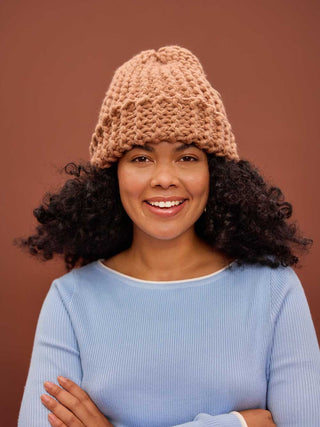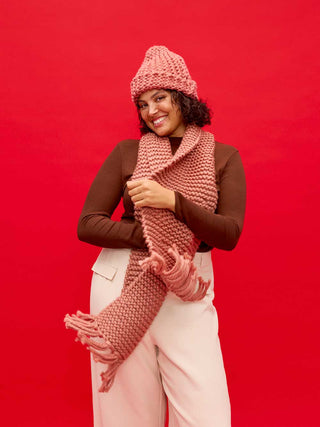A step by step guide to knitting the Smith Beanie.
Ever gotten half way through a project and thought “Hang on, am I even doing this right?”
We have 🙋♀️
That’s why we’ve created these step by step overviews to help guide you through the knitting process.
THE BASICS
If you're a total knitting newbie - WELCOME! Learning to knit can feel like learning code. We've stripped away the complicated jargon and tried to keep things really simple. 🧶
Before we get started on the pattern it’s a good idea to learn the basic stitches you’ll need to complete your masterpiece. You can use the yarn that came in your kit to practice with. The video below covers every technique you'll need to learn (spoiler - there are really only 5 things!). Learn how to cast on, do a knit stitch, a purl stitch and put them together to create a 1x1 rib stitch, lastly, we learn casting off. Once you've got these mastered you'll find this pattern is a cinch!
💭 For more detailed videos of each technique, head down a little further where we've got specific videos for each stitch type. 🚨 While the Smith is knitted in Mohair (not Merino as shown in the videos) the techniques are exactly the same 🤓 👩🎓
🏅🧶 You got this! ⚡️💪
Remember learning a new skill can be a little hard at first and you’re bound to find yourself making some mistakes along the way. But as with learning anything, your brain and your hands slowly start to get the hang of it, muscle memory is created, and soon the thing you found tricky/daunting/scary is like second nature!
If you get stuck, reach out to us and we'll give you a hand! 😎
TEST YOUR TENSION
Before you start, you should make sure your tension (how tightly or loosely your knitting is) is spot on. We knit a “tension swatch” to make sure the tension is juuuust right. It's a bit like goldilocks, if the tension is too tight, your piece will be too small, and if it's too loose it may not hold its shape and might be too big.
If done correctly, your 10x10cm knitted swatch should be 8 stitches high and 11 rows wide when knitted on 12mm needles. To test this, jump on your 12mm needles and cast on around 16 stitches, then knit in stockinette stitch (row 1 knit, row 2 purl) for around 12 rows. Then use the card that came in your kit to measure 10x10cm and count your stitches and rows to make sure you're knitting at the correct tension.
WHAT YOU’LL NEED
Your kit comes with everything you need to knit your masterpiece.
- 10mm circular needles
- Two balls of our Chunky Mohair yarn
- Darning needle
THE TECHNIQUES YOU’LL MASTER
CASTING ON
Casting on is the first step in any project. It's the term we use for getting the wool onto our needles! We recommend using the two-needle technique as it's one of the simplest methods. Two-needle cast on uses your two needles (surprise!), starting with a slip knot on your left needle, each stitch is knitted to form a new loop and this loop is then added to your left needle. You repeat until you’ve made the desired number of stitches.
💭 Casting on, like many things in knitting, can be done in a number of ways - our suggestion is a simple technique but you can pick any that’s right for you.
KNIT STITCH
This handy little stitch makes up the backbone of most knitting patterns. Each knit stitch looks like a little ‘v’.
PURL STITCH
The second most common stitch, purl stitches look like little bumps (or purls!). You knit a knit stitch with your yarn tail at the back of your work and your needle going into the back of the stitch, the purl is the opposite, so your yarn tail is at the front of your work and your needle goes into the front of the stitch.
2x2 RIB STITCH
A rib stitch is a textured pattern usually used on the cuffs and necks of jumpers. It’s made by alternating knit and purl stitches in the same row, then knitting the same stitch sequence in the next row. We knit the Smith in 2x2 rib stitch which means that we knit 2 stitches, then purl 2 stitches.
KNITTING IN THE ROUND
Knitting in the round is where we use our circular needles and knit continuously in loops, rather than back and forth in rows (like a lot of beginner patterns do). Now don't worry! It's not anywhere near as hard as it sounds. When knitting in the round, you're always knitting on the "front" side of your work so you don't need to turn the piece to knit on the "back" side. Plus, you don't need to sew your beanie together at the end!
REDUCING STITCHES
We reduce stitches in the final rows of the beanie to give it the shape it needs. This is done by knitting or purling some stitches together. This simply means we put our right needle into the second stitch on your left needle and collect both the first and second stitch and knit them as you would a single stitch.
OKAY, LET’S KNIT UP A STORM!
We knit our beanie from the bottom up. Smith is knitted in a 2x2 rib stitch, so once you've cast on you'll be knitting the same 4 stitch combination (knit 2, purl 2) for the majority of your work.
CHUNKY MOHAIR
We knit our Chunky Mohair double strand. This means you have two strands on the go at once. To start with, we suggest pulling one tail from one ball and one from another. As you get more confident you can work with one ball if you like, you'll just use both ends of the ball.
💭 🚨 Now, a little word of caution when knitting with two strands. It's a lot easier to put your needle through your stitch in the wrong place when you're knitting with two strands. If you do this you'll end up with more stitches on your needle than you've cast on 🤯 We recommend counting your stitches every few rows as you knit to make sure you haven't added any rogue stitches. If you have, and it's picked up quickly, you can knit two stitches together on the next row to get back to your correct number of stitches for the piece.
Here's what knitting double strand looks like when you cast on.


Step 1:
Grab your 10mm needles and let's cast on the allocated number of stitches. Now, if you want to follow our knitting in the round technique from the video above, we recommend adding an extra stitch to your cast on.
This is what your work will look like with all your stitches cast on. This example is knitted in Merino but the technique is the same for Mohair 😊

Step 2:
Once you've cast on the right number of stitches you're going to join your work in the round.

And you're going to knit the 2x2 rib stitch for the allocated number of rows. Remember to mark the start of each loop with a stitch marker and tick off the circles to keep track of each row you've completed.
💭 A stitch marker can be anything round; a ring, hair tie or a spare piece of yarn.
This is what your work will look like after you've knitted your first loop of 2x2 rib stitch.

And this is what it looks like when you've knitted the allocated number of rows.

Step 3:
Next, we're going to decrease some stitches. In this row you'll knit the first two stitches as usual, and then you'll purl the next two stitches together. Just slip your right needle in through the front of the first and second stitches in your left needle and purl them as you would a single stitch. Continue this pattern for the full loop.
Step 4:
This is not a decrease row, so we'll continue the new pattern we've got of knitting two stitches, then purling one stitch.
Step 5:
Okay, now we'll decrease stitches by knitting two stitches together, and then purling the next. See how your beanie is tapering nicely?
Step 6:
This is not a decrease row so we'll just knit 1 and purl 1 for the full loop.
Step 7:
Last decrease! We'll knit two stitches together for the length of the row.
You'll have 11 stitches left on your needles now. This is what it will look like.


Step 8:
Onto the last part! Time to grab your darning needle. We'll cut our yarn from our ball (you'll want about 20cm to work with), and thread the darning needle with it. Then use your darning needle to pick up the remaining 11 stitches in a counter-clockwise direction. Once all the stitches are collected you can slip the 10mm needles out of the work and now it's just a case of using the darning needle to secure those stitches. We like to continue in a counter-clockwise direction and thread the yarn back around the top of the beanie to keep it nice and secure. Then tie a knot on the inside of the beanie to keep it secure.
The last thing we do for every piece is weave in the ends. That’s basically just tidying up the piece so all loose ends are trimmed down and tucked in.
FINITO! You are done! 💪🔥
Time to rock that baby out and about 😎
We'd 💕LOVE💕 to see how you go! Share your masterpiece with us by tagging @cardigang_knits on socials or by sending us an email at hello@cardigang.com.au
Until next time! 😘🧶
Morgan & Cat xx



















